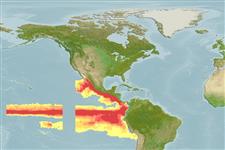Actinopterygii (ray-finned fishes) >
Stephanoberyciformes (Pricklefishes, bigscales and gibberfishes) >
Melamphaidae (Bigscale fishes or ridgeheads)
Etymology: Melamphaes: Greek, melan, -anos = black + Greek, amphi = both side (Ref. 45335).
Environment / Climate / Range
Ecology
Marine; bathypelagic; depth range 62 - 500 m (Ref. 51657). Deep-water, preferred ?; 30°N - 23°S, 120°W - 130°W (Ref. 87970)
Eastern Pacific Ocean: tropical, endemic to ETP, from the California coast (ca. 30°N) down to northern Chilean coast (ca. 23°S).
Size / Weight / Age
Maturity: Lm ? range ? - ? cm
Max length : 12.8 cm SL male/unsexed; (Ref. 87970)
Short description
Morphology | Morphometrics
Dorsal
spines
(total): 3;
Dorsal
soft rays
(total): 13-16;
Anal
spines: 1;
Anal
soft rays: 8;
Vertebrae: 27 - 28. The species is characterized by the following: large head (more than 40% of SL, specimens of SL ? 100.0 mm); first gill arch with 20-22 rakers; total vertebrae 26-28, 11 abdominal; haemal arch of the first caudal vertebra is without a spur; D III,13-16; P14-15; ventral fin with 7 soft rays; ventral fin starts before the vertical line of the posterior margin of the pectoral fin basement; anal fin starts under the vertical line of the 3-4 ray of the dorsal fin (posterior end); operculum with 4 scales (Ref. 87970).
Adults caught below 400-500 meters; juveniles in shallower water (Ref. 51657). Specimens were sampled by open-mouth nets at depth range of 1500-0 m; the minimal sampling depth was 62 m (individuals with SL = 12.7-13.3 mm) (Ref. 87970).
Life cycle and mating behavior
Maturity | Reproduction | Spawning | Eggs | Fecundity | Larvae
Kotlyar, A.N., 2011. Revision of genus Melamphaes (Melamphaidae). II. Multi-raker species: M. polylepis, M. falsidicus sp. nova, M. pachystomus sp. nova, M. macrocephalus, M. leprus. J. Ichthyol. 51(8):658-661. (Ref. 87970)
IUCN Red List Status (Ref. 115185)
CITES (Ref. 94142)
Not Evaluated
Threat to humans
Harmless
Human uses
More information
Common namesSynonymsMetabolismPredatorsEcotoxicologyReproductionMaturitySpawningFecundityEggsEgg development
Age/SizeGrowthLength-weightLength-lengthLength-frequenciesMorphometricsMorphologyLarvaeLarval dynamicsRecruitmentAbundance
ReferencesAquacultureAquaculture profileStrainsGeneticsAllele frequenciesHeritabilityDiseasesProcessingMass conversion
Tools
Special reports
Download XML
Internet sources
